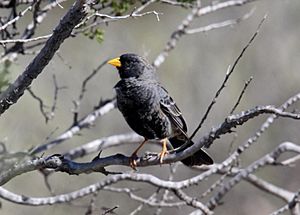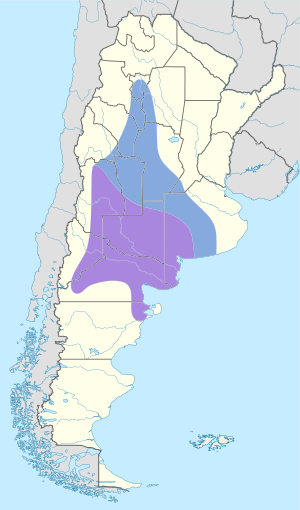Carbonated sierra finch facts for kids
Quick facts for kids Carbonated sierra finch |
|
|---|---|
 |
|
| Conservation status | |
| Scientific classification | |
| Genus: |
Porphyrospiza
|
| Species: |
carbonaria
|
 |
|
| Synonyms | |
|
Phrygilus carbonarius |
|
The carbonated sierra finch (Porphyrospiza carbonaria), also called the carbon sierra finch, is a small bird. It belongs to the Thraupidae family, which includes many types of tanagers and finches. This bird is special because it is found only in Argentina.
Contents
What is the Carbonated Sierra Finch?
This bird gets its name from its dark, almost charcoal-like feathers. The word "carbonated" refers to its dark color, like carbon. It's a type of finch, which means it has a strong, cone-shaped beak. This beak is perfect for cracking open seeds, which are a big part of its diet.
Where Does It Live?
The carbonated sierra finch lives in specific places in Argentina. It prefers dry areas with lots of shrubs and open grasslands. These places are called subtropical or tropical dry shrubland and temperate grassland. "Endemic" means it is found naturally only in this one country. It doesn't live anywhere else in the world!
Its Natural Home
Imagine wide-open spaces with scattered bushes and tall grasses. That's the kind of place this finch calls home. These habitats provide both food and shelter. The shrubs offer places to hide from predators and build nests. The grasslands are full of seeds and insects for the birds to eat.
What Does It Eat?
Like many finches, the carbonated sierra finch mainly eats seeds. Its strong beak helps it break open tough seed shells. It might also eat small insects, especially when feeding its young. Eating insects provides important protein for growing chicks.
Conservation Status
The carbonated sierra finch is currently listed as "Least Concern" by the IUCN. This means that its population is stable. It is not considered to be in danger of extinction right now. However, it's always important to protect their natural habitats.
Why Protecting Habitats Matters
Even if a species is not endangered, its home can still be at risk. Things like farming, building, or climate change can affect their habitats. Protecting these areas helps ensure the carbonated sierra finch continues to thrive. It also helps other animals and plants that share the same environment.
See also
 In Spanish: Yal carbonero para niños
In Spanish: Yal carbonero para niños


